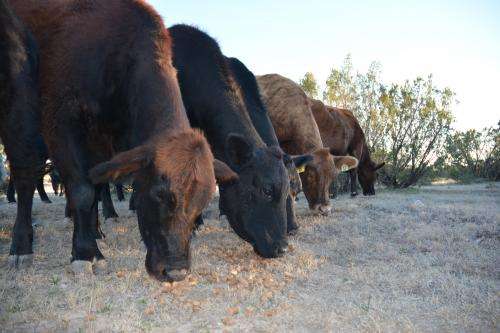Genomic-enhanced data has a place in building back cattle herds, according to expert

Genetic markers are beginning to give cattlemen a more accurate glimpse into their breeding animals' expected progeny differences or EPDs when selecting for traits to build into their herds.
As the industry begins to rebuild its herds following years of drought, genomic-enhanced EPDs can help cattlemen make more informed decisions, whether they have purebred or crossbred herds, said Dr. Joe Paschal, Texas A&M AgriLife Extension Service livestock specialist at Corpus Christi.
Speaking at the recent Southwest Beef Symposium in Amarillo, Paschal said the Angus and Santa Gertrudis breed associations are already using this tool and he expects others to soon adopt the technology.
Paschal said two things are important when building a crossbreeding program – breed selection and hybrid vigor.
"You need to make selections that fit the market conditions and the environmental conditions you have, because you have to live with those breeds," he said. "Make sure the right breeds are used for the right reasons."
Typically, a breeding animal is chosen based on its EPD for a given trait, such as weaning weight. For instance, one bull may have an EPD of 20 for weaning weight and another bull have an EPD of 10, which means the bull with the EPD of 20 will likely sire calves that wean 10 pounds heavier.
EPD traits of interest are birth weight and weaning weight, calving ease score and carcass traits such as marbling, Paschal said. EPDs are calculated from the animal's data and close relatives and are reported in units of the trait.
"You need to select for all traits that are important to you," he said. "But traits that are economically relevant, those that have an immediate impact on rate of return, are most important. Selection for economically relevant traits such as weaning weight could increase several pounds or marbling by a large percentage. Selection to decrease birth weight, even by a few pounds, doesn't affect economics, but selection to increase calving ease does."
EPDs are not new and are widely accepted in most breeds and have a lot of usefulness in crossbreeding programs, Paschal said.
However, he said, the newer genomic-enhanced EPDs can get breeders a step ahead.
"This process is taking genetic markers and including them into the EPD calculation," Paschal said. "We can compare known markers in particular young bulls that may not be proven yet and we can improve the accuracy of their EPD values."
He said less than 5 percent of the people in the cattle business are in the purebred industry, and some of them aren't going to use it. But with the price becoming more reasonable, $50 for the genomic scans for markers, more could be switching.
"It makes sense to do it if you are in the cattle business because it gives you a leg up on the others," Paschal said. "You can know something about the performance early in an animal's life and also know quite a lot about their carcass long before they're dead."
Provided by Texas A&M University




















